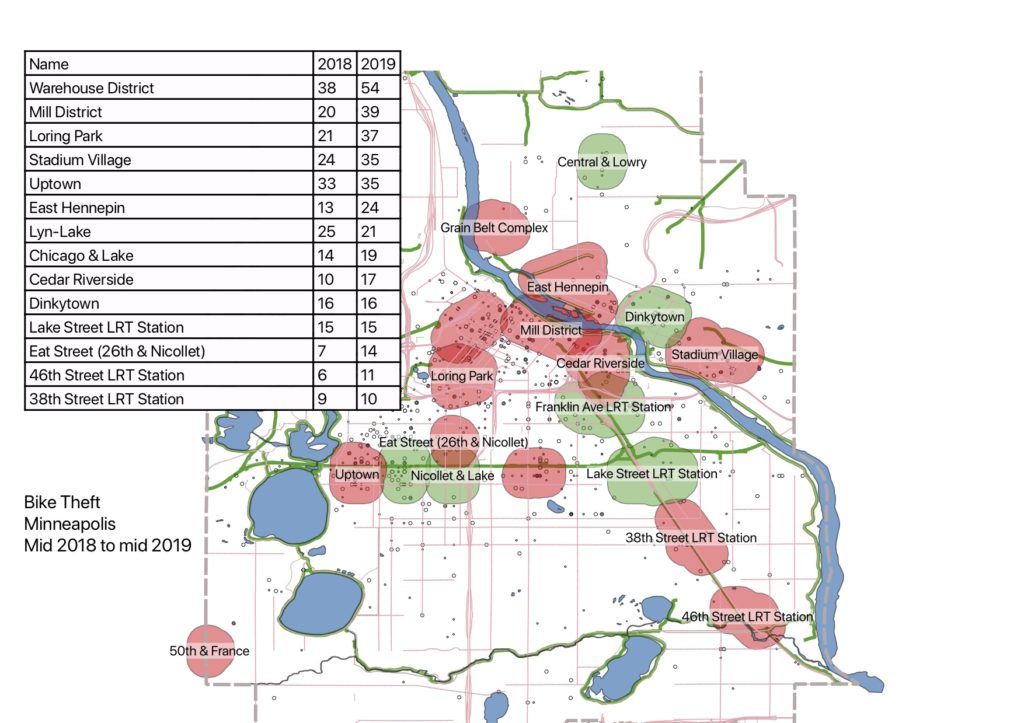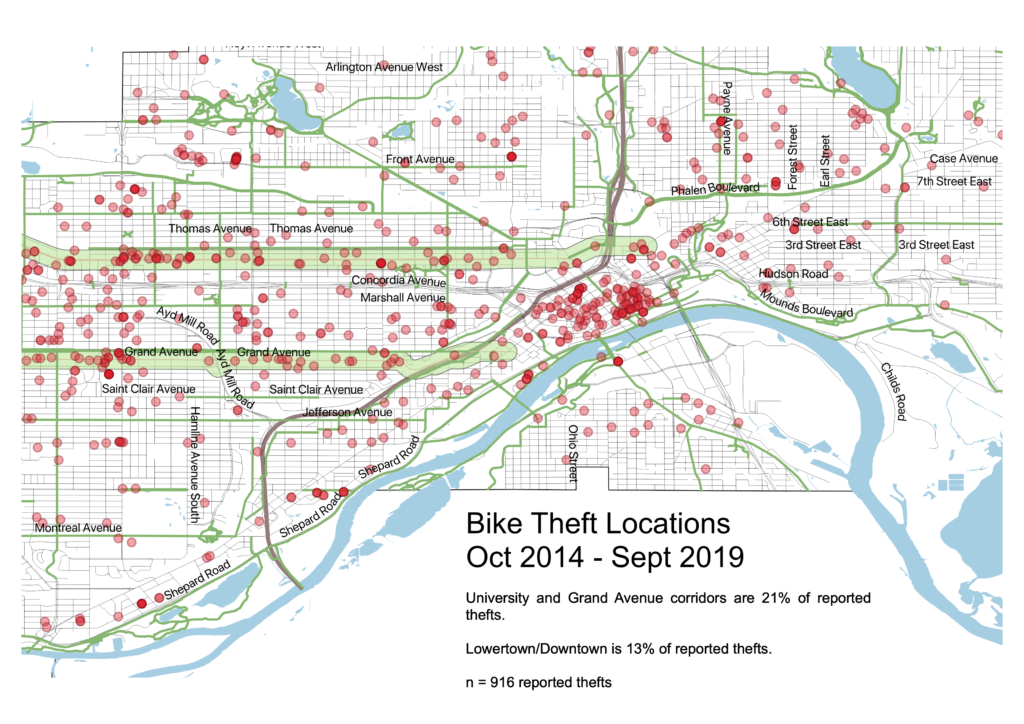Why should you care about bike theft? The most straightforward reason is: because it could happen to you (if it hasn’t already). The less obvious answer: because 7 percent of bike theft victims quit riding entirely and 25 percent of victims ride less than before (Source: Project 529). Those numbers are significant; cost out an infrastructure solution that would increase your bike mode share by 7% and get a quarter of cyclist to ride more frequently. It would take many years and many millions in funding. Ending bike theft is one of the most cost effective ways to improve cycling. Now do we have your attention?
Before we opened a bike shop bike theft wasn’t something we gave much thought to. But nearly every day since we opened we heard stories of bike theft, and many days we heard more than one story. Now we care. The victims of bike theft run the demographic spread; in one week we took in bikes from a suit and tie guy, a lifeguard and a senior citizen on a fixed income. The losses were: a wheelset, a bent derailleur hanger, and a rear wheel and saddle (respectively). A new rear wheel is: $45 for the wheel, $15 for the tire, $8 for the inner tube, $15 for the freewheel (aka cogs), and $20 for labor. That’s north of a hundred bucks when tax is included. You may now be piecing together why someone would stop riding after a theft.
Theft Prevention
- Buy a good lock. U-locks and folding locks are the best; cable locks are the worst. We’re no longer stocking cable locks because when you buy one from us you’re (basically) paying to have someone (eventually) steal your bike. The better locks have theft coverage from $500 to $4000.
- Never park outside overnight. Give a thief enough time and he will break any lock. Take a look at the map below to see where you should never leave your bike overnight.
- Never leave your bike unlocked. We’ve heard many sad tales that start with ‘I just parked it in front of the store for a couple minutes while I ran in.’
- Be aware of your environment. Certain locations draw both bikers and thieves. (Why do you rob banks? Because that’s where the money is.) When you find a place to lock up, look around and see if there are people just sorta hanging out. If you get bad vibes then find somewhere else to lock up or bring your bike inside with you.
- Lock to something secure. Wiggle the rack, post or pole. If it moves or lifts out of the sidewalk then don’t use it. (Earn a merit badge by reporting it to 311.) The lock should go around the frame and a wheel (if possible). Keep the lock away from the ground because the thief can use the ground as leverage for a bolt cutter or jack.
- Register your bike and report theft. Do this now: take a photo of your bike, turn it over and record the serial number (found on the bb shell), put that information in a draft email and keep it… for that day… that most dreadful day. If you are a renter or homeowner with insurance, add the bike(s) to your policy. Register your bike. We like the National Bike Registry (Project 529). If your bike is stolen then please file a police report. Pretty please?
- Never purchase a stolen bike. Duh, right? Wrong. We get people coming through our door all the time asking if we buy parts. Nope. How much is this bike worth? We dunno; how much did you pay for it? Before you consider buying a used bike examine the bike and scrutinize the seller. Does the bike have obvious damage that might have been caused by a theft? Does the seller seem to know the bike? Does the bike have a backstory? Warning signs: not knowing the maintenance history, not knowing the mileage, not knowing the place of purchase, not knowing how to operate the shifters and brakes, and a bike that is the wrong size or wrong “application” for the seller. Finally, when in doubt, remember this: it is a crime to receive stolen property.
- Get better bike parking. Remember #3? There was nowhere to lock the bike. Here’s a fun thought experiment: Imagine that you are a driver and you don’t know if your destination will have any parking, and there’s a decent chance that your car will get stolen; do you roll the dice and drive, take the bus, or stay home? Parking policy is transportation policy.
- Help us make bike theft an issue.
Theft by the Numbers
St. Paul reports 916 bike thefts occurring during the period October 2014 through September 2019. So far the worst year has been 2016 with 189 thefts, however 2019 is on pace to surpass that with 184 thefts reported through September 30. Data point: the final quarter of the year — on average — accounts for 15% of the bike theft total. Conclusion: 2019 will be a record year.
[A]ccording to Project 529, of the hundreds of thousands of bikes recovered by police every year, less than 1% are registered and fewer than 5% are returned to their rightful owners.
And to further highlight the problem of bike thefts, it is estimated only 20% of stolen bikes are reported to police, more than 50% of stolen bikes used a cable lock instead of the more secure U-lock, and fewer than 20% of bike owners know the serial number on their bike.
(Source: Vancouver Urbanized)
Again, this is why we don’t sell cable locks and why when a bike comes in for a tune up we record its serial number and take its photo.
Bike theft appears to be a worse problem elsewhere. Last time we checked (late August), Minneapolis had logged more than 1,000 reported thefts. Now I know more people in Minneapolis ride, and it is a bigger city, but I have to wonder whether Minneapolis is also better at logging those thefts. Portland, Oregon’s law enforcement has assembled a task force to address their bike theft problem. Here’s what that looks like.
Theft by Location
We live in the age of BIG DATA, right? So it should be easy to figure out where bikes are being stolen. Wrong. The City of St. Paul doesn’t seem to geocode its crime data, and it semi-annonomizes street addresses by replacing the last digit of a street address with an X. For example, 137X UNIVERSITY AV W. Minneapolis, by contrast, does geocode its crime data, so making this map takes about 30 minutes once the dataset is located. 
Compounding the challenge in St. Paul is that Ramsey County records address points as 1371 University Avenue West. So here’s what I did:
- Using QGIS I changed the Ramsey County address points to read like St. Paul police address points. I changed the last digit of the street number to an X (1371 became 137X), I abbreviated the street type (Avenue became AV), I did the same with street direction (West became W), and I made the text string ALL CAPS.
- Then I filtered the 220,000 line database of all reported crime in St. Paul (August 2014 to present day) looking for bike thefts. Throwing a bone here to St. Paul because it categorizes bike theft by monetary value (Under $500, $500-$1000, and over $1000).
- Finally I joined databases to associate theft locations with actual addresses.
- With that I was able to map just over 700 theft locations. The thefts which occurred near intersections were still problematic so I had to manually geocode 40 or 50 intersections. The final map captures about 95% of reported thefts. The thefts are transparent red dots (helps to show overlap) and the bike infrastructure appears as green line data. The light green buffer is what I used to count thefts one block on both sides of the University and Grand Avenue corridors.
Findings
- If you turn off the street layer you can still figure out where the major streets are. Bike theft follows major streets.
- Mapping theft by community council district shows that Union Park experienced a 3x increase in bike theft this year. There were 8 reported thefts in 2018 and 27 so far this year.
- Looking at 1 block on both sides of the University and Grand Avenue corridors captures more than 20% of all bike thefts in St. Paul. Downtown/Lowertown is also a hotspot at 13% of all thefts.
Limitations
- The St. Paul database only includes reported thefts.
- While each theft is coded by property value (good!) that value assessment must be made by the victim and officer.
- The accuracy of these pins isn’t perfect: we can drop the pin on the same block as where the theft occurred but we still won’t know which side of the street and whether the theft was mid block or at either end. Without geotagged crime data this is the best we can do.
Next steps
Working on those. For now we will keep advising our patrons about how to beat the thieves.
